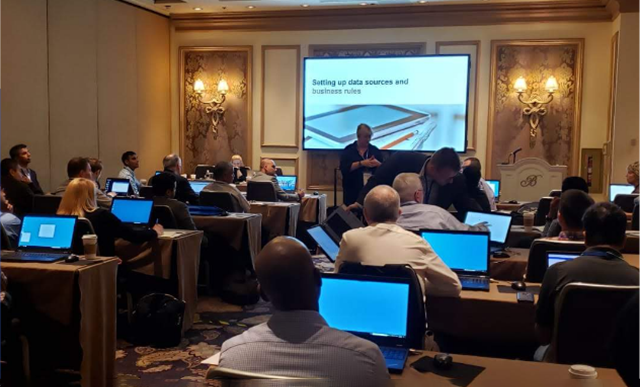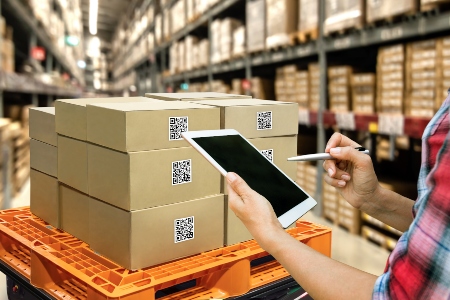Dan Roam and the Power of the Visual Mind
SCM Optimization Speaker on Using Vision to Unlock Data
Dan Roam, best-selling author of five books on business visualization, joins SAPinsider for a podcast on how using the power of our visual mind in a business setting can lead to supply chain efficiencies. Roam is a speaker at the SAPinsider SCM Optimization Bootcamp, presented by Reveal, with two sessions on the topic.
Below is a slightly edited transcript of the conversation with SAPinsider’s Ken Murphy.
Ken Murphy, SAPinsider: Hi, this is Ken Murphy with SAPinsider. I am joined on today’s podcast by Dan Roam, who is the president of Digital Roam, Inc., and the author of five international best-selling books on business visualization including “The Back of the Napkin: Solving Problems with Pictures” and his newest book “Draw to Win”, which debuted at No. 1 on Amazon in the Business Communications and Sales Marketing categories.
Explore related questions
Dan is a speaker at the SAPinsider SCM Optimization Bootcamp which begins May 7 in New Orleans, and he has two sessions on business visualization techniques. Dan and his whiteboard have appeared on CNN, NBC, Fox, and NPR. Dan, thank you for your time today and thanks for joining us.
Dan Roam: Ken, my pleasure. I love talking about pictures so having the chance to do it with SAP folks and supply chain folks is a pleasure for me.
Ken: Great. We’re hearing a lot of buzz about the event, people are looking forward to it. Just a few questions for you today. If you could just address visualization techniques. Why are they important, and why are they effective in a business setting?
Dan: That’s such a great question. I have really spent the last 15 years of my career focusing on business problem-solving from the perspective of understanding the power of our visual mind. And the reason I’ve come to emphasize that is I’ve realized going back into the cognitive science of vision that of course vision is far and away the most powerful of all our senses. But even more incredibly if you actually look down into the neurological basis of how vision works it turns out that more than half of our brain – more than half of the human brain – is dedicated to the processing of vision. And what I’ve tried to do is say for business people, especially people who face really complex problems like supply chain and supply chain management, is (to find out if) there’s a way to take advantage of this incredible processing horsepower that every one of us has in our heads, this visual engine, and take advantage of that and really be able to see what the problem is that we’re trying to solve.
And what I and colleagues of mine have discovered is the answer is “Yes”. When you can see what the problem is, when you can see over the entire supply chain and detect anomalies with your sense of vision, it’s really remarkable how rapidly you can zero in on what are the things that really need to be fixed, and even then begin to see what the solutions are.
Ken: A lot of enterprises, and that includes many SAP customers, rely on dashboards for reporting. Is the power of imagery that you just discussed – is that something different?
Dan: It’s both something different, and it’s related. On a side note, I’m a pilot. I learned how to fly when I was a kid in high school. My dad was a flight instructor. And so I spent a lot of time learning how to navigate an aircraft. And of course the whole idea of a dashboard comes typically from a machine. You’re driving a car, and you’ve got a dashboard or you’re flying a plane and you’ve got a dashboard. And what a dashboard is providing you with is a set of visual tools that are kind of like your senses, into the machine or the system that you’re trying to operate. And I’ve been really excited over the last couple of decades as a lot of the human-computer interface decisions, a lot of the understanding of human visual cognition, has made its way into business dashboards. So to answer your question, yes dashboards like the kinds that are driven by SAP systems that allow you to have a visual sense of what’s going on within the machine, within the system, are incredibly valuable and those are exactly the types of visual tools that I’m talking about.
And, I’m also adding on an additional layer on top of the dashboards. A step back and take a bigger holistic view of the overall supply chain, over the overall problem; dashboards are fabulous in of course being able to show you individual exceptions within a step within a supply chain, and to be able to give you a very rapid sense of what is the overall flow at particular points in a process or a supply chain.
What I also love is the ability to take a pen and paper in hand and sketch out on a piece of paper, on a white board, what is your interpretation on a big picture level of what you think the dashboard is telling you as it connects to the other dashboards? I’m a big fan of being able to look at a visual dashboard and have it give you the insights that you need specifically. And then be able to take that information and using the power of your visual mind on a piece of paper capture what is the intersection of the data that I’m getting from that dashboard, with the information that I’m seeing from this other dashboard, and what does that mean at an even bigger picture level?
So, two levels. The dashboard is a kind of specific visualization, and then the broader step back and look at the big picture, combined.
Ken: Dan, one knock on large companies is that they’re set in their ways and often resistant or slow to change. I’m wondering if you find that this is the case with visualization, and what results do businesses achieve that can help them embrace change?
Dan: Of course big industries and big businesses traditionally have been slow to change – it’s the idea of the innovator’s dilemma: The thing that you become really, really good at doing you get so good at doing it that you stop trying to do new things. As businesses grow, for reasons that make perfect sense they’re incented to continue to do the same stuff over and over and optimize it and optimize it, which is great. So when you come along like me or like many people who have a kind of an innovative idea or new approach, sometimes it’s a bit of an uphill battle to try to get a business to try to do something new.
But I’ll tell you Ken, what I’ve found when it comes to the power of the visual, when you have exposed people – even the most conservative of business types, those that are most loathe to kind of change the operation – when people see what the power is of being able to visually understand a problem and visually recognize the patterns that are within it, people mobilize pretty fast to say, “Yeah, I want some of those tools.” Because the measurable impact is pretty close to immediate and pretty remarkable.
What I’m referring to, if you do think back it wasn’t that long ago whether it was in financial services or in supply chain, the primary way that any one of us as an operator had to look at what was going on inside the system was spreadsheets, tons and tons and tons of data. Which was great, because it was really good to look at the data but it was also hard to visually parse it. And then, to your previous question, along came some very smart people who said, “Well, if we put this into a visual dashboard that will help people see the data much more effectively.” And guess what? Those dashboards were adopted pretty fast because the value is evident. And that’s exactly what I’m seeing.
I’m not really at liberty to discuss a bunch of client names but I can say I’ve had a chance over the last several years to work with the largest retail company on the planet which when they talk about supply chain, they refer to it as “dirt to dirt” – from resource being pulled out of the ground all the way through this being manufactured, produced, delivered, stored, sold at retail, taken to the customer’s home and ultimately recycled. So if you imagine the broad scope of “dirt to dirt” we’ve had a lot of success on being able – even with an organization as big as this retailer is – being able to say “My gosh, if you can see each step of the journey of that product all the way through, it’s pretty remarkable where you can start to find levers that will turn and optimize things.” So, lots of good success and the same in high tech companies that I work with. And I think the real essence is, visualization and the ability to see problems and see the patterns really does sell itself. Dashboards are a start, and I’d like to encourage people to start think more broadly about how they can use those kinds of visual tools to see even bigger challenges and solutions.
Ken: Dan, how does creating visual thinkers and communicators apply specifically then to helping solve supply chain complexities?
Dan: As I was mentioning, working for this big retailer with their “dirt to dirt” supply chain, one of the things I’ve learned and I think this applies; I’m doing a lot of work right now with people in the steel industry, so a much more constrained kind of a supply chain but still a fully realized, fully complicated – one thing we can agree on with every supply chain is they’re complicated – so in the steel industry all the way from customer demand all the way through sourcing of scrap, every step in steel manufacturing, every step involving inventory and then delivery to the end customer. It’s a really, really complicated supply chain.
What we’re finding is the ability to work at two different levels, two different visual levels at the same time is very important. And those two levels, we kind of touched on them a moment ago, level No. 1 is being able to see the broad picture, the entire supply chain from beginning to middle to end. And at a high level, what are all the steps and inflection points across that supply chain? Great, that’s view No. 1. View No. 2 is the vertical view, the deeper view that says that at each point in that chain, as I drill down into specific dashboards and data sets that I have, I’m going to look at it a little bit differently now and I’m going to be looking at things in terms of their detail and looking for specific exceptions and anomalies and where are they being driven?
If I can take a step back, imagine it as kind of the letter “T”. The crossbar on a capital letter “T” represents the horizontal view of the supply chain; we need to be able to see that, that’s more holistic, that’s the big picture. And then the upright on the letter “T” is the drill-down, in detail into the specific data and what I know is happening at each point. And that’s why I really love the power of the visual and the way we describe it, to be able to learn to see both the big picture and the detail, both of them broad and deep and our vision system conceptually is really, really good at doing that.
Ken: And how does visual strategy fit in with the business trend of digital transformation, which is where we have companies bringing emerging technologies such as IoT, AI, and machine learning into business processes to better serve the customers?
Dan: Gosh, what a fabulous question and happily I think I have an equally fabulous answer. Part of the reason I’ve gotten involved with the steel industry over the last year is because I’m actually doing a lot of work in artificial intelligence. And here’s one of the things that you find; artificial intelligence when it intersects with supply chain is really, really cool. Because before I started getting into the depths of artificial intelligence I had this notion that AI was kind of like Hal in the old movie 2001, it’s this all-seeing, all-knowing computer that is actually running the spaceship. And I’ve realized, no, that’s not what AI does. What AI does, is it senses the data – it’s the same with Internet of Things – you have so many sensors, and an overwhelming amount of information that’s coming in from every point in the system. So what’s really cool is AI has the ability because it has more processing than you or I do, to be able to take in more of that data. Well that’s great, but then what it can do with more data than a human can handle, is it can make better predictions of what’s likely to happen from these multiple data sources.
Now where does the visual part come in? Here’s what I’ve learned: What AI really does, is it presents you, the user, with its recommendations in the form of data visualizations. The primary way that we humans interact with AI is through data visualizations. Dashboards on steroids, dashboards cubed, where the machine is trying to say from all of these disparate data sources that I’ve pulled all this information, here is what I think you human need to know and see in order to make the best decision. And that’s all visual. And this is what I find so remarkable, is that we talk about digital transformation the access to an overwhelming amount of data that we have never had before is fantastic because it tells us so much about our systems which we didn’t know. But at a huge cost of needing to be able to actually see that data, there’s so much – we need our machines, we need our data interfaces, and we need our really, really beautiful UIs, user interfaces, to make sure that we’re using visuals to understand the information that’s coming. So I see a direct linkage between the ascendancy of digital transformation, access to the data, and the need to be able to see it more clearly. And the only way we’re going to do that is again through visualization.
Ken: Lastly Dan, many of the attendees at the upcoming SCM Optimization event will be SAP customers and supply chain professionals. What’s the biggest value or takeaway from your sessions that they can bring back to their organizations?
Dan: They’re going to have the ability to see both the full horizontal story of their supply chain, and the ability to see more deeply into the specific verticals than they have been before. The real benefit is understanding that my visual mind is incredibly powerful, so powerful that I actually am a lot smarter than I ever thought I was. And that is true for all of us; and the real benefit I think is being able to say, “I understand enough about how vision really works and I mean the human process, the neurobiological, neurocognitive process of vision. Understanding how that works, I now have the ability to highjack that incredible horsepower and bring it back with me to the office and literally show my colleagues things that are buried in the data that they were never able to see before.”
Ken: Dan, thank you very much for joining us today. Dan again is a speaker at the SCM Optimization Bootcamp, which starts May 7 in New Orleans. Dan, good luck at your sessions and we’ll look forward to seeing you in New Orleans.
Dan: All right, Ken. Thanks so much, I’ll see you there.
The SAPinsider SCM Optimization Bootcamp is May 5-7 in New Orleans. Dan’s session “The Back of the Napkin: How to Solve Complex Business Challenges with Simple Pictures”, will be held Tuesday, May 8, at 12:45. A business visualization design thinking workshop will be held Tuesday, May 8, at 2 p.m.





